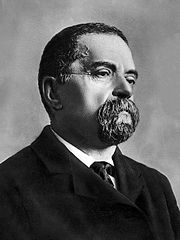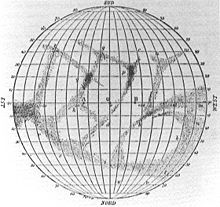Giovanni Schiaparelli
Giovanni Schiaparelli | |
|---|---|
 Giovanni Schiaparelli | |
| Born | Giovanni Virginio Schiaparelli 14 March 1835 |
| Died | 4 July 1910 (aged 75) |
| Nationality | Italian |
| Scientific career | |
| Fields | Astronomy |
Giovanni Virginio Schiaparelli ForMemRS HFRSE (/ˌskæpəˈrɛli, ˌʃæp-/ SKAP-ə-REL-ee, SHAP-,[2][3] US also /skiˌɑːp-/ skee-AHP-,[3][4] Italian: [dʒoˈvanni virˈdʒiːnjo skjapaˈrɛlli]; 14 March 1835 – 4 July 1910) was an Italian astronomer and science historian.
Biography
[edit]He studied at the University of Turin, graduating in 1854, and later did research at Berlin Observatory, under Encke. In 1859–1860 he worked in Pulkovo Observatory near St Petersburg, and then worked for over forty years at Brera Observatory in Milan. He was also a senator of the Kingdom of Italy, a member of the Accademia dei Lincei, the Accademia delle Scienze di Torino and the Regio Istituto Lombardo, and is particularly known for his studies of Mars.
Mars
[edit]
Among Schiaparelli's contributions are his telescopic observations of Mars. In his initial observations, he named the "seas" and "continents" of Mars. During the planet's "great opposition" of 1877, he observed a dense network of linear structures on the surface of Mars, which he called canali in Italian, meaning "channels", but the term was mistranslated into English as "canals".[5]
While the term "canals" indicates an artificial construction, the term "channels" connotes that the observed features were natural configurations of the planetary surface. From the incorrect translation into the term "canals", various assumptions were made about life on Mars; as these assumptions were popularized, the "canals" of Mars became famous, giving rise to waves of hypotheses, speculation, and folklore about the possibility of Martians, intelligent life living on Mars. Among the most fervent supporters of the artificial-canal hypothesis was the American astronomer Percival Lowell, who spent much of his life trying to prove the existence of intelligent life on the red planet.[5] After Lowell's death in 1916, astronomers developed a consensus against the canal hypothesis, but the popular concept of Martian canals excavated by intelligent Martians remained in the public mind for the first half of the 20th century and inspired a corpus of works of classic science fiction.
Later, with notable thanks to the observations of the Italian astronomer Vincenzo Cerulli, scientists came to the conclusion that the famous channels were actually mere optical illusions. The last popular speculations about canals were finally put to rest during the spaceflight era beginning in the 1960s, when visiting spacecraft such as Mariner 4 photographed the surface with much higher resolution than Earth-based telescopes, confirming that there are no structures resembling "canals".
In his book Life on Mars, Schiaparelli wrote: "Rather than true channels in a form familiar to us, we must imagine depressions in the soil that are not very deep, extended in a straight direction for thousands of miles, over a width of 100, 200 kilometres and maybe more. I have already pointed out that, in the absence of rain on Mars, these channels are probably the main mechanism by which the water (and with it organic life) can spread on the dry surface of the planet."
Astronomy and history of science
[edit]
| 69 Hesperia | 29 April 1861 | MPC |
An observer of objects in the Solar System, Schiaparelli worked on binary stars, discovered the large main-belt asteroid 69 Hesperia on 29 April 1861,[7] and demonstrated that the meteor showers were associated with comets.[8] He proved, for example, that the orbit of the Leonid meteor shower coincided with that of the comet Tempel-Tuttle. These observations led the astronomer to formulate the hypothesis, subsequently proved to be correct, that the meteor showers could be the trails of comets. He was also a keen observer of the inner planets Mercury and Venus. He made several drawings and determined their rotation periods.[8] In 1965, it was shown that his and most other subsequent measurements of Mercury's period were incorrect.[9]
Schiaparelli was a scholar of the history of classical astronomy. He was the first to realize that the concentric spheres of Eudoxus of Cnidus and Callippus, unlike those used by many astronomers of later times, were not to be taken as material objects, but only as part of an algorithm similar to the modern Fourier series.[citation needed]
He was elected to the American Philosophical Society in 1901.[10]
Honors and awards
[edit]
Awards
[edit]- Lalande Prize (1868)
- Gold Medal of the Royal Astronomical Society (1872)
- Bruce Medal (1902)
Named after him
[edit]- The main-belt asteroid 4062 Schiaparelli,[8] named on 15 September 1989 (M.P.C. 15090).[11]
- The lunar crater Schiaparelli[8]
- The Martian crater Schiaparelli[8]
- Schiaparelli Dorsum on Mercury[12]
- The 2016 ExoMars' Schiaparelli lander.[13]
Relatives
[edit]His niece, Elsa Schiaparelli, became a noted designer or maker of haute couture.[14]
Selected writings
[edit]- Sulla determinazione della posizione geografica dei luoghi per mezzo di osservazioni astronomiche (in Italian). Milano. 1872.
{{cite book}}: CS1 maint: location missing publisher (link) - 1873 – Le stelle cadenti (The Falling Stars)
- Osservazioni sulle stelle doppie (in Italian). Milano: Hoepli. 1888.
- Sulla distribuzione apparente delle stelle visibili ad occhio nudo (in Italian). Milano: Hoepli. 1889. Bibcode:1889sdas.book.....S.
- 1893 – La vita sul pianeta Marte (Life on Mars)
- 1925 – Scritti sulla storia della astronomia antica (Writings on the History of Classical Astronomy) in three volumes. Bologna. Reprint: Milano, Mimesis, 1997.
References
[edit]- ^ "Senato Website". Archived from the original on 18 March 2009. Retrieved 14 March 2009.
- ^ "Schiaparelli, Giovanni Virginio". Lexico UK English Dictionary. Oxford University Press.[dead link]
- ^ a b "Schiaparelli". The American Heritage Dictionary of the English Language (5th ed.). HarperCollins. Retrieved 5 August 2019.
- ^ "Schiaparelli". Merriam-Webster.com Dictionary. Merriam-Webster. Retrieved 5 August 2019.
- ^ a b Washam, Erik, "Cosmic Errors: Martians Build Canals!", Smithsonian magazine, December 2010.
- ^ "Minor Planet Discoverers (by number)". Minor Planet Center. 23 May 2016. Archived from the original on 26 April 2020. Retrieved 20 June 2016.
- ^ Schmadel, Lutz D. (2007). "(69) Hesperia". Dictionary of Minor Planet Names – (69) Hesperia. Springer Berlin Heidelberg. p. 22. doi:10.1007/978-3-540-29925-7_70. ISBN 978-3-540-00238-3.
- ^ a b c d e Schmadel, Lutz D. (2007). "(4062) Schiaparelli". Dictionary of Minor Planet Names – (4062) Schiaparelli. Springer Berlin Heidelberg. p. 347. doi:10.1007/978-3-540-29925-7_4041. ISBN 978-3-540-00238-3.
- ^ Defrancesco, S. (April 1988). "Schiaparelli's determination of the rotation period of Mercury: a re-examination". Journal of the British Astronomical Association. 98: 146–150. Bibcode:1988JBAA...98..146D.
- ^ "APS Member History". search.amphilsoc.org. Archived from the original on 19 May 2021. Retrieved 19 May 2021.
- ^ "MPC/MPO/MPS Archive". Minor Planet Center. Archived from the original on 26 April 2020. Retrieved 4 July 2016.
- ^ "Schiaparelli Dorsum". Gazetteer of Planetary Nomenclature, International Astronomical Union (IAU) Working Group for Planetary System Nomenclature (WGPSN). Archived from the original on 19 May 2024. Retrieved 19 October 2016.
- ^ Patterson, Sean (8 November 2013). "ESA Names ExoMars Lander 'Schiaparelli'". Space Fellowship. Archived from the original on 15 May 2019. Retrieved 8 November 2013.
- ^ "ELSA SCHIAPARELLI". Vogue. Archived from the original on 7 August 2014. Retrieved 17 December 2014.
Further reading
[edit]- Chisholm, Hugh, ed. (1911). . Encyclopædia Britannica. Vol. 24 (11th ed.). Cambridge University Press. pp. 322–323.
- "Schiaparelli, Giovanni Virginio (1835–1910)", biography from www.daviddarling.info.
- Obituaries: G. V. Schiaparelli, J. G. Galle, J. B. N. Hennessey J. Coles, J. E. Gore, The Observatory, Vol. 33, p. 311–318, August 1910
External links
[edit] Source texts from Wikisource in Italian and English.
Source texts from Wikisource in Italian and English.- Le Mani su Marte: I diari di G.V. Schiaparelli. Observational diaries, manuscripts & drawings. Historical Archive of Brera Observatory. (in Italian)
- Works by Giovanni Virginio Schiaparelli at Project Gutenberg
- Works by or about Giovanni Schiaparelli at the Internet Archive
Obituaries
[edit]Lua error in Module:Navbox at line 192: attempt to concatenate field 'argHash' (a nil value).
- 1835 births
- 1910 deaths
- Discoverers of asteroids
- Foreign members of the Royal Society
- Corresponding members of the Saint Petersburg Academy of Sciences
- Honorary members of the Saint Petersburg Academy of Sciences
- Foreign associates of the National Academy of Sciences
- 19th-century Italian astronomers
- Italian historians of science
- People from Savigliano
- Recipients of the Bruce Medal
- Recipients of the Gold Medal of the Royal Astronomical Society
- Recipients of the Pour le Mérite (civil class)
- Members of the Senate of the Kingdom of Italy
- University of Turin alumni
- Recipients of the Lalande Prize
- Recipients of the Cothenius Medal
